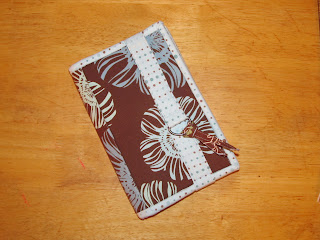I was able to complete so much sewing work today! It felt great to get it all done, but it was a struggle on the way. The most difficult project turned out to be this Ereader cover.
I love the fabrics and how it turned out, but it was frustrating to get it sized to fit my specific reader. I used my seam ripper more for this project that I have on any other single project ever!
The pattern is the Reader Wrap from Atksinson designs. A cute pattern, but a bit oversized for my Kindle Fire.
The surface area for the reader was too large for mine so I had to cut that down. There was also too much space in the spine which caused the cover to fit too losely and sloppily. The original pattern called for a bottom pocket to hold the reader in that had a hole cut for the power button and plug ins. I thought the pocket was really cute and gave it a try, but it didn't hold the reader snuggly enough so I opted to eliminate it. Holding the reader in with elastic bands worked well enough on my store bought cover so I deided to use four of these instead. In addition, I wrapped the elastic with black pleather to get a better grip on the surface of the reader since the elastic alone was allowing the reader to slip. After all of these alterations I am happy with the look of the cover, but I'm not sure yet whether or not I will like its functionality. I'll have to use it for a while and see.


Comments
Post a Comment